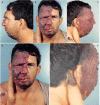Surgical Management of Facial Port-Wine Stain in Sturge Weber Syndrome
- PMID: 33585124
- PMCID: PMC7872872
- DOI: 10.7759/cureus.12637
Surgical Management of Facial Port-Wine Stain in Sturge Weber Syndrome
Abstract
Sturge Weber Syndrome is characterized by the classic triad of a facial port-wine stain, leptomeningeal angiomatosis, and glaucoma. The resultant facial vascular anomaly can lead to soft tissue and bone irregularities, causing psychosocial distress and mental health morbidity. When severe, patients can opt for multi-staged surgical intervention by reconstructive surgeons to restore normal symmetry and improve the aesthetic appearance of the face. This study reports a case of surgical correction for severe facial vascular malformation resulting in poor outcomes due to the associated mental comorbidities seen in Sturge Weber Syndrome. A 37-year-old male with previously diagnosed Sturge Weber Syndrome presented to the outpatient craniofacial clinic for surgical evaluation of a large facial tuberous hemangioma. The patient underwent multiple operations for facial reconstruction including a staged full-thickness skin graft, facial recontouring, and extracranial correction of vertical orbital dystopia. The case was complicated by the patient's poorly controlled seizure disorder and psychosocial illness, resulting in self-mutilation of the repair and poor follow-up. Over the span of 10 years, the patient's mental illness caused him to fail numerous attempts at facial restoration and ultimately led to a poor final result. The psychosocial distress seen in patients with Sturge Weber Syndrome can adversely affect surgical outcomes. Physicians should be mindful of the possible complications that can arise in these patients and have the clinical means to address them.
Keywords: capillary malformation; encephalotrigeminal angiomatosis; mental health; port wine stain; sturge-weber syndrome.
Copyright © 2021, Ainuz et al.
Conflict of interest statement
The authors have declared that no competing interests exist.
Figures










References
-
- Sturge-Weber syndrome: a review. Thomas-Sohl KA, Vaslow DF, Maria BL. Pediatr Neurol. 2004;30:303–310. - PubMed
-
- Update on Sturge-Weber syndrome: diagnosis, treatment, quantitative measures, and controversies. Comi AM. Lymphat Res Biol. 2007;5:257–264. - PubMed
-
- Sturge-Weber syndrome. Nabbout R, Juhász C. Handb Clin Neurol. 2013;111:315–321. - PubMed
-
- Sturge-Weber syndrome: a review. [Article in En, Spanish] Higueros E, Roe E, Granell E, Baselga E. Actas Dermosifiliogr. 2017;108:407–417. - PubMed
-
- Sturge-Weber syndrome. Comi AM. Handb Clin Neurol. 2015;132:157–168. - PubMed
Publication types
LinkOut - more resources
Full Text Sources
Other Literature Sources
